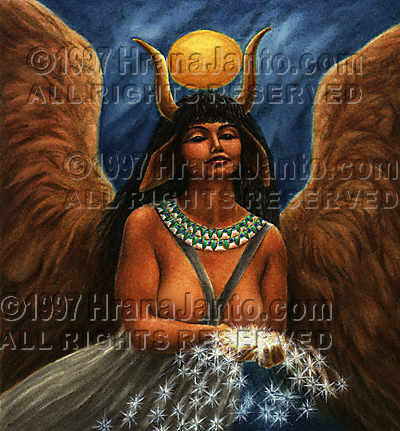 |
|
|||||
PREVIOUS | NEXT | A,B,C, D,E, F,G,H,I, J,K,L,M, N,O,P,Q, R,S, T,U,V,W,X,Y,Z | Help | ALL | INDEX
| Hathor from Goddesses and Heroines |
Exerpt from Goddess & Heroines by Patricia
Monaghan [Used by permission. This text is NOT included in the Goddess Oracle] |
One of the world's greatest goddesses, Hathor was worshiped for more than a millennium longer than the life, to date, of Christianity. For more than 3,000 years her joyful religion held sway over Egypt.
Small wonder, then, that a profusion of legends surrounded her, or that she was depicted in so many different guises: at once mother and daughter of the sun, both a lioness and a cow, sometimes a woman, and sometimes a tree. One of the world's greatest goddesses, Hathor was worshiped for more than a millennium longer than the life, to date, of Christianity. For more than 3,000 years her joyful religion held sway over Egypt.
Small wonder, then, that a profusion of legends surrounded her, or that she was depicted in so many different guises: at once mother and daughter of the sun, both a lioness and a cow, sometimes a woman, and sometimes a tree. Goddess of the underworld, she was also ruler of the sky. Patron of foreigners, she was mother of the Egyptians. Like Ishtar to the east, she was a complex embodiment of feminine possibilities.
One of Hathor's most familiar forms was the winged cow of creation who gavebirth to the universe. Because she bore them, she owned the bodies of the dead; thus she was queen of the underworld. Again, she appeared as the seven (or nine) Hathors who materialized at a child's birth and foretold its inescapable destiny. Then too, she was the special guardian spirit of all women and all female animals.
"Habitation of the hawk and birdcage of the soul," Hathor was essentially the body in which the soul resides. As such, she was patron of bodily pleasures: the pleasures of sound, in music and song; the joys of the eye, in art, cosmetics, the weaving of garlands; the delight of motion in dance and in love; and all the pleasures of touch. In her temples, priestesses danced and played their tinkling tambourines, probably enjoying other sensual pleasures with the worshipers as well. (Not without cause did the Greeks compare her to Aphrodite.)
Her festivals were carnivals of intoxication, especially that held at Dendera on New Year's Day, when Hathor's image was brought forth from her temple to catch the rays of the newborn sun, whereupon revels broke out and throbbed through the streets. (In this capacity she was called Tanetu.) She was a most beloved goddess to her people, and they held fast to her pleasureful rites long into historical times.
| Back to TOP | Published by Llewellyn, copyright 1997. Used by permission of the author. |
![]()